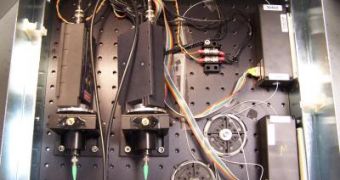Each second, vast amounts of valuable information - from your personal credit card numbers to state and military secrets - are targeted by individual hackers and crackers, or worse, by criminal organizations, but now, new technologies are emerging, based on the surprising laws of quantum physics that govern the atomic scale.
The National Institute of Standards and Technology (NIST) claims to have created a prototype high-speed quantum key distribution (QKD) system that can produce an unbreakable "one-time pad" encryption, transmission and decryption of a video signal in real-time over a distance of at least 10 kilometers.
Quantum keys are the latest development in encryption technology. Quantum cryptography uses quantum mechanics for secure communications. Unlike traditional cryptography - which depends on the computational complexity of mathematical techniques to restrict the possibility that eavesdroppers might learn the contents of encrypted messages - quantum cryptography depends on the fact that naive attempts to read quantum information will destroy the information (there is no way to copy unknown quantum states).
Since quantum key distribution has been theorized for the first time, two decades ago, the IT companies have been engaged in a continuous race to build a fast, practical and reliable QKD system.
The institute says that the scientists have solved some of the most important problems in quantum cryptography, like the compatibility with existing fiber-optic telecom networks that transmit at wavelengths of either 1550 or 1310 nanometers (nm) to reach the greatest distance, or the efficiency of the photon detector in picking up single photons reliably without introducing significant amounts of "noise."
NIST took advantage of one of the best low-noise detectors, a silicon-based avalanche photo diode (Si-APD), for which they designed a sub-system that converts single photons from a transmission wavelength of 1310 nm to 710 nm for high-efficiency detection.
The resulting QKD system can generate and transmit secure keys at a speed of over half a million bits per second over 10 km of optical fiber, fast enough to encrypt streaming digital video using one-time pad in real time, which is a distance 10 times greater than any previous experiments have succeeded.
The new applications will definitely benefit from the high speed, high efficiency, low noise and convenience of operation in a single fiber without significant interference.

 14 DAY TRIAL //
14 DAY TRIAL //